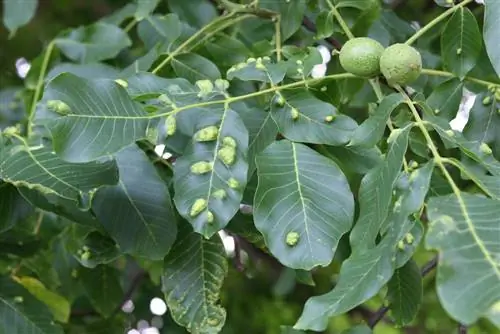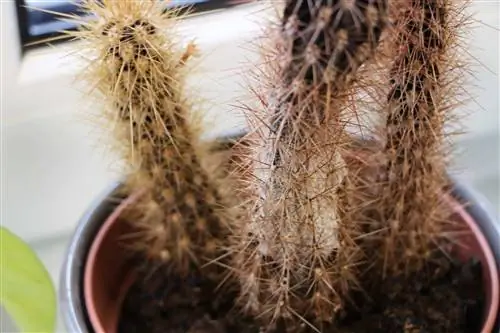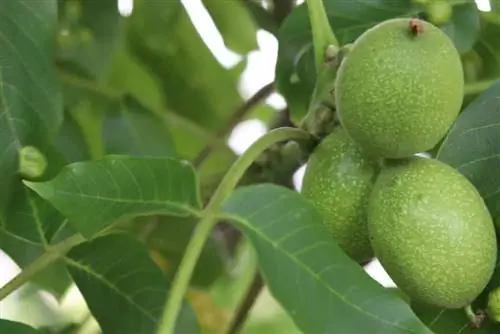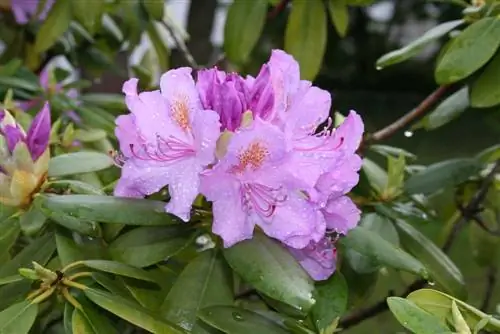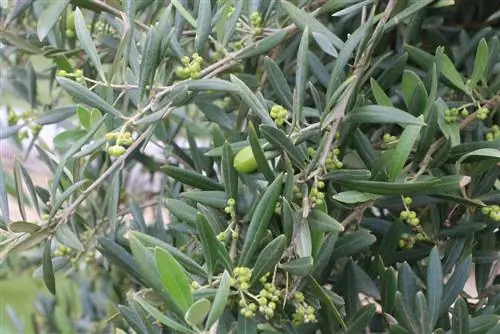- Author admin [email protected].
- Public 2023-12-17 03:39.
- Last modified 2025-01-24 12:45.
The walnut tree is a real eye-catcher in summer with its magnificent foliage. Not only does it provide shade, but it also rewards plant lovers with a bountiful walnut harvest. However, the prerequisite is he althy growth. Although it is one of the most robust tree species, some pests and diseases can still make life difficult for it. You can find out what these are and how to combat them in the following guide.
It's better to be safe than sorry
The real walnut tree or common walnut tree, popularly known as walnut tree for short, is a strong and robust specimen when he althy. It has a natural defense organism that protects it extensively from diseases and numerous pests. But there is never 100 percent protection for plants, so the Juglans regia can also be affected.
At the beginning of every illness and pest infestation, he uses all his strength against it. But if the progression of the disease is not stopped and pests can multiply unhindered and deprive it of its life energy, not only will the nut harvest often fail, but the walnut tree can be in life-threatening danger.
Tip:
For the reasons mentioned, this robust walnut plant should be checked regularly for possible diseases and pests so that you can act quickly and prevent worse things from happening by controlling them - in some cases, unfortunately, there is no effective control.
Walnut tree diseases
Here are the typical diseases that can affect a walnut tree:
Cherry leaf roll virus
Cherry leaf roll virus is also known as walnut blackline disease. This is an infectious disease that progresses slowly and can lead to death, especially in weakened trees.
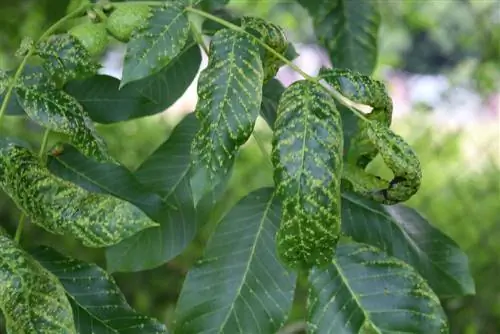
Recognize
- Yellow line patterns and yellow spots on the leaves and fruits
- Fruits and leaves fall off
- Black line formations on woody areas
- Dead tissue forms on the grafted branches
- branches dried up
- New shoots are no longer forming
Combat
An effective control is not yet known. The virus spreads so quickly inside that even cutting off affected areas at the first visible signs is already too late.
Powdery mildew (Erysiphaceae)
The walnut tree is susceptible to powdery mildew, especially in dry months and warm summers. In contrast to downy mildew, which only prefers humid climates, real mildew is also known as a “fair weather fungus”, although humidity does not deter it. Powdery mildew is a fungus that can be easily controlled if treated quickly. It is called a false mushroom because it leaves a visual impression, but is more closely related to brown algae and diatoms.
Recognize
- In the early stages there is only white, sticky fungal coating on the tops of the leaves
- In the later course of the disease, a white fungal carpet can also be seen on the undersides of the leaves
- It then migrates to all green parts of the plant
- Coating becomes brownish to grayish over time
- Stunted fruit heads
- Some leaves turn the side edges up
- Leaves dry up and fall off
- If powdery mildew is left untreated, it can penetrate into the tree trunk and cause it to die
Combat
There are various methods available to combat powdery mildew on walnut trees, all of which have been proven to be effective.
Soap suds
- Depending on the size of the infestation and the tree, add an appropriate amount of water with strong soap
- Only those without chemical additives are suitable as soap
- Pour soapy water into a tip pump
- Spray foliage dripping wet with soapy water
- Make sure that all parts of the plant are sprayed from each side
- If the white fungal carpets have not disappeared after five to six days, repeat the process
- Do not spray in the blazing sun or in the hot midday sun
- Choose a dry day for spraying - it is optimal if there are further dry days so that the soapy water can work and is not washed away by rain
Plant protection products
A plant protection product against powdery mildew is available in every specialist retailer. Here you should make sure that night sulfur or other organic active ingredients are included. If you spray the walnut tree with it every year before flowering, you will keep powdery mildew away. If this has already spread on the tree, a pesticide is one way to combat it. Even if the ingredients are organic, treatment is less advisable if the fruit is already present, as the liquid gets into the inside of the fruit and eating the fruit is not recommended. The soapy water, on the other hand, can be used safely.
Fungal Infection
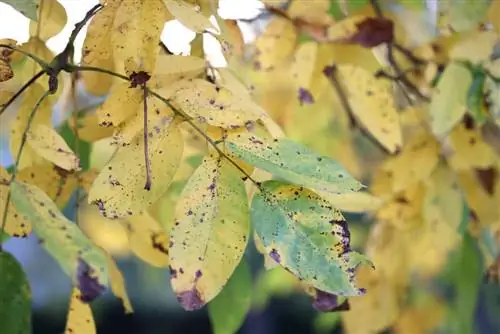
There are countless species of mushrooms that settle in gardens every year. Some are more stubborn to combat and cause severe and sometimes life-threatening damage, while others have little impact on the walnut tree. But in any case you should react, because it is almost impossible to accurately identify which fungus it is. An expert can certainly help you on site, but combating it immediately solves the problem even without knowing the fungus by name. As a rule, walnut trees show more or less the same symptoms when infected with fungus.
Typical characteristics of a fungal infestation
- Brown and grayish brown leaf discoloration
- Curled and/or stunted leaves
- Leaves dry and fall off more and more
- Growth disorders
- New shoots fail to appear or grow very thinly
- Thin green branches hang weakly
- Many smudges on the leaves and/or green branches
- Trees are increasingly thinning out
- Fruits do not develop, do not develop properly or fall off immature
Combat
Fungicides
The fastest and most effective are usually fungicides that are specifically designed for fungal treatment and are available for purchase in specialist stores. It is recommended to only use organic products. Most of them ensure that the existing fruits remain suitable for consumption despite spray treatment. In addition, treatment with organic fungicides is environmentally friendly. If you use chemical products, you must expect the walnuts to be contaminated with pollutants. The extent to which these could endanger your he alth when consuming the walnuts depends on the respective ingredients and dosages. It should also be taken into account that chemical fungicides are also toxic to insects and should therefore only be used with special precautions - or simply avoid them and only use an organic fungicide to combat fungi.
Exception: tree fungus infestation
In addition to the tiny fungal spore infestation of various types of fungi, tree fungus infestation can also occur. This can be observed much more often. Real fungal sponges usually form on the tree trunk. These are not always edible and are not always harmful to the walnut tree. Nevertheless, you should take action.
- As soon as you suspect the first signs of possible tree fungus infestation, you should remove them so that the fungus does not spread
- Score the bark/wood with a sharp knife
- If green tissue appears, control can still be effective
- If the inner tissue has dried out or shimmers yellowish-green, the fungus is already inside
- In this case, control with conventional measures is not possible
- It is advisable to consult an expert, if necessary from the plant protection office
- This person can explicitly assess what needs to be done or whether felling is necessary
Bacterial infestation
Walnut trees are repeatedly affected by bacteria, which in the worst case scenario can even cause the death of large, strong trees. Typically, bacterial transmission occurs through the use of infected pruning tools and large cuts that allow bacteria to enter the interior of the tree.
Recognize
Growths usually form on branches or the trunk as a result of a bacterial infection. These can become immensely large and create holes, especially on the trunk. The so-called tree canker usually results from a bacterial infestation.
Fight
In many cases it is sufficient to cut out large areas of the growths. If they are hanging on a branch, it should be cut back until fresh green appears inside. This is a sure sign that the area is (still) he althy. The interfaces must then be covered with coal ash or special resin for wound closure on plants. This way no new bacteria can invade.
Tip:
Always make sure to use disinfected cutting tools when pruning trees. Only cut on dry days and always close larger cutting surfaces to avoid bacterial infestation.
Walnut tree pests
These pests can be expected on the walnut tree:
Aphids
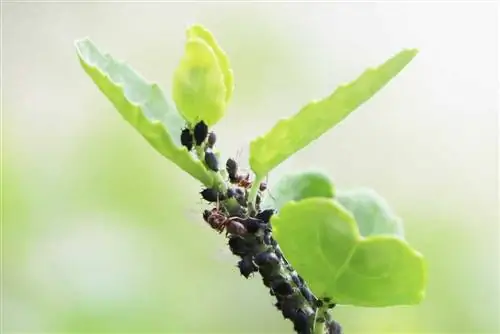
Damage from aphids can only be expected if an extensive infestation is noticeable and the leaves curl up severely. Otherwise the Julians regia gets along well.
Recognize
In order to recognize aphids, you would have to get quite close to the leaves, as the small, brown, black or greenish animals, which are only a few millimeters in size, are hardly visible. You can use the following signs to orient yourself:
- Sticky coating on the leaves (honeydew)
- Rolled and partly stunted leaves
- Yellow leaves
- Leaves dry up and fall off
- Mostly colonies can be seen mainly on new shoots
Fight
- If the infestation is manageable, cut off affected branches down to the he althy area
- Then spray the tree with strong pressure (washes away any remaining animals)
- For severe, large-scale infestations, make highly concentrated soapy water
- Add around 500 milliliters of rapeseed oil for every ten liters of soapy water (it sticks the respiratory organs of the aphids together)
- Spray the tree dripping wet
- Repeat the process after about three days
Caterpillars
Bluescreen, willow borer and butterfly caterpillars are happy to cause problems on walnut trees. Blue screen caterpillars in particular often leave massive damage behind. They have a yellowish-white body up to six centimeters in size on which there are so-called point warts. Once they have eaten their way into the inside of branches and trunks, they form a hollow tunnel system.
Combat
When combating it, it is important that you do it early, before the caterpillars have worked their way into the interior of the tree. Once they get there, you can no longer reach them and fighting them is impossible.
Collect
If there are not too many caterpillars and the walnut tree is not very tall, you can collect the caterpillars by hand. Another variant is shaking down. To do this, place a sheet of foil on the ground and either shake the still small tree or work your way from branch to branch with, for example, a broom. You can then dispose of the caterpillars that have fallen onto the film with household waste.
Cutting
If it is a light infestation in the early stages and the caterpillars are on the branches, you can remove them from the walnut tree by cutting off the affected branches. Telescopic pruning shears are advantageous for tall specimens.
Neem oil
Neem oil plant products are available commercially that can be used to effectively combat caterpillars on walnut trees. You can use this to spray the tree or just the affected parts of the plant. The neem oil settles in the caterpillars' respiratory tract, which subsequently suffocates.
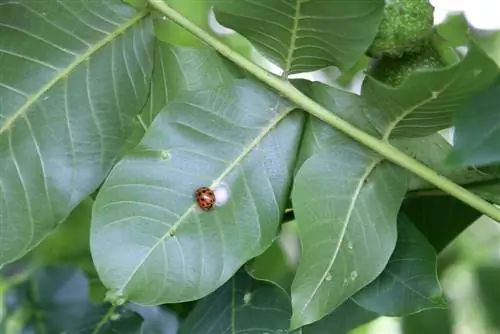
Walnut fruit fly (Rhagoletis completa)
The walnut fruit fly is not the direct problem, but the maggots. From around July/August they lay their eggs in the fruit shells. As a result, they leave black dots on the green fruit peels. The maggots penetrate the fruit walls and eat them. A clear characteristic is a soft, moist fruit that dries out more or less as it progresses. Because they only penetrate the pulp, the walnuts can still be eaten as long as they are not completely dry. All you have to do is remove the black pulp from the nut.
Combat
Pick up fallen walnuts every day and either remove the nut immediately or throw it away. In this way, pupation is prevented and the walnut fruit fly does not multiply. Cherry fruit fly traps can be hung in the treetop and should be replaced or cleaned daily. If you place a close-meshed net around the walnut tree from June onwards, you will also prevent walnut fruit flies from getting into the branches to lay their eggs in the fruit peels.

